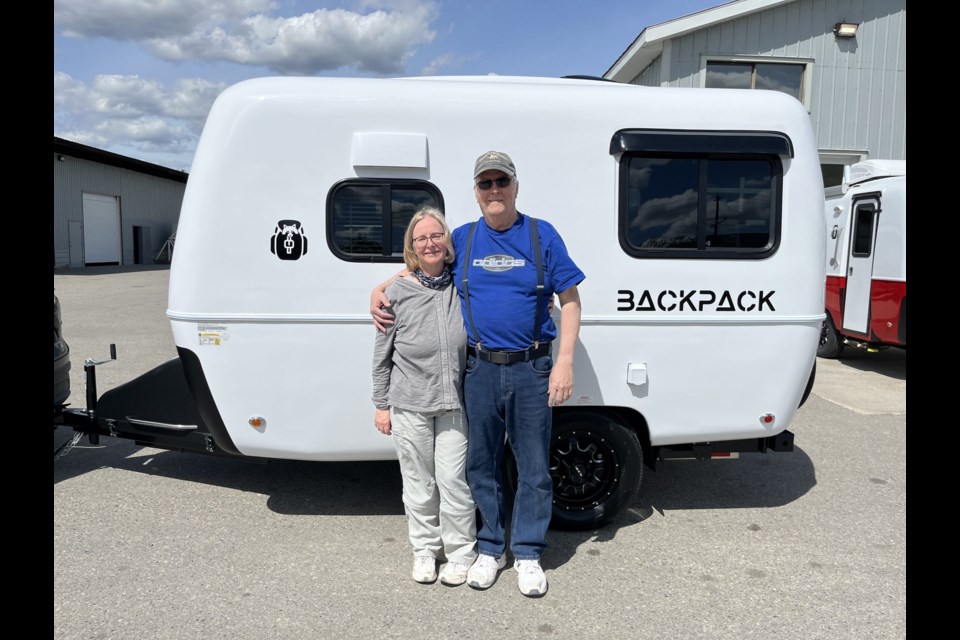We all have reacted to the Covid-19 pandemic in many ways. Travel opportunities have been much reduced and the present situation, as shown at airports, doesn’t show much immediate improvement.
Many Canadians are reconnecting with more simple ways of enjoying travel outdoors through camping experiences. We have done a fair amount of that over the years, with a pop-up camper trailer or tent, and wanted to continue. Today’s camping styles vary from the simple tent, camper vans, innovative home-built trailers and ranges of trailers in many lengths, right up to what I refer to as condos on wheels.
With an interest in the tiny house craze, my wife Claudia started to look into tiny trailers. There are many of these available today in many interesting configurations.
We had always admired the older Boler and Trillium trailers from back in the day. My wife learned, while visiting with her older brother in B.C., that a similar style trailer was being built nearby, and she and was instantly interested. Initially built in Enderby, the Armadillo Company has expanded to a new facility in Armstrong, B.C. They produce two custom style trailers — the Armadillo and the Backpack model. The family producing these had actually bought the moulds that the Boler trailers had been produced with. With extensive upgrades and custom options, they offer a variety of styles within the two models. Due to disruptions to the supply chain from COVID, and fires and floods in B.C. which caused additional interruptions, our trailer delivery date was extended. When word came that it was in the final stages of production, we made our move to drive to B.C. On the way out, we travelled through the U.S. and avoided the winter weather still being reported at that time in northern Ontario, Manitoba and Saskatchewan.
We were quite excited to finally see our Backpack sitting outside the Armstrong, B.C. factory where it was built. We were warmly welcomed by Mike, given instructions on some of the features by his son, Carter, helped with our hitch set-up, and before we knew it we were driving off the lot, towing our ‘tiny’ trailer and set for some camping experiences on our way home to Ontario.
Our first major trip after picking up the new Backpack was to continue west from Vernon to Fort Langley. This gave us the opportunity to visit with my wife’s brother and wife for several days. The day trip took us on some highways where the results of B.C. fires and floods were quite obvious as we travelled. Entire bridges, overpasses and sections of highway needed to be rebuilt and work was quite obvious in these areas. Also, along the highway was major pipeline construction. In several areas, trees were burned right down to the highway and it was obvious that the fires had ‘jumped’ the road and continued on the other side.
Fort Langley has a municipally-run campsite, Fort Camping in Brae Island Regional Park just on the outskirts of the town itself. It provides comfortable sites if you happen to visit the area. I took the opportunity to walk one of the trails on the island and was able to view and photograph the lush forest growth typical to the area. It’s a pleasant walk that takes you along the bank of the Bedford Channel, ending at a tidal flat where the channel and the Fraser River meet.
The city itself is quite active, being much like Niagara-on-the-Lake and quite popular as a tourist destination. I was particularly interested in touring the Parks Canada site of the old Fort Langley itself and had a great walkabout. This is touted as British Columbia’s birthplace, and was a fur trading post established by the Hudson Bay Company in the early 1800s. A tour of the fort allows for a great opportunity to learn about the operation of this fur post.
The interpretive staff were wonderful at explaining their ‘roles’ at each of the buildings. We certainly came away with a better understanding of the role it played in early colonial British Columbia.
Stay tuned for part two of Dave and Claudia’s trip across Canada.
